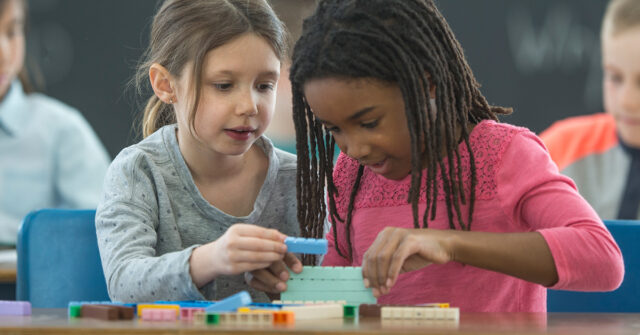
By Janelle W. Henderson
As a movie lover, I watched Hidden Figures happily yet was frustrated that yet another Black narrative was hidden from us for so long. As an elementary teacher, I felt ashamed. We want our students to love everything we teach, including math. But how are we truly making it relevant to them? How do we honor and expound on their interests instructionally? More specifically, we want the Black students and students of color we teach to understand and enjoy math, but do our methods demonstrate that? The film was a part of my wake-up call, yelling at me that I was projecting white men as the norm for mathematicians by not showing a counternarrative of Black mathematicians in my math instruction.
Additionally, the film stirred up my own math insecurities. I was a student who was in advanced math since fourth grade and was in a math honor society in high school. Yet, if you asked me how to explain math, I had no understanding beyond the formula or just “getting it.” When I took math in college, I hated it and hated the course outlining how to teach math. Even after that class, I still couldn’t deconstruct math in the way I could reading, so of course I couldn’t share with my students a conceptual understanding of math. Watching the movie brought all those feelings back to life.
For the past two years, I’ve been blessed to teach mostly Black students in third grade, almost all of whom loved math. They didn’t care about their math grades, but they enjoyed doing and were inquisitive about the actions related to math: counting, adding, multiplying, and dividing.
I made a conscious decision to end the shame of memorizing algorithms and formulas yet not really understanding what I was doing mathematically. I asked myself, “Sis, how are you teaching math if you don’t really comprehend what you’re doing?!” I began prioritizing teaching math in the same way I prioritized my reading instruction.
I had to acknowledge the harsh reality that to best support my students and relieve myself of math anxiety as both a student and teacher, I needed to understand math more conceptually and teach in that same vein. What does it really mean to add? To subtract? To do fractions? How do I use the math I’m teaching in my everyday life? I worked with math coaches at my school, tried new approaches to teaching math, and joined a yearlong fluency math group within my school. For the first time ever, I put the same work into my math instruction as I had in my reading instruction.
My research question remains the same: In what ways do culturally responsive practices impact Black boys' identity and perceptions of school in a third-grade classroom?
In this essay, I’ve focused on how my mathematical instruction allows Black boy brilliance to soar, using a few small changes in my instructional practice. (Of course, I’ve been equally concerned with Black girl identity and perception, especially in math by having the intersecting marginalization of being Black and female; it’s just not a part of my study within this fellowship.)
Climate
I started the year by cultivating a high-trust climate. This took many forms and is most evident in acting based on what my students say. I ask students, “What do you need?” and figure out a way to give them what they are asking for as often as possible. In building that high-trust environment, I’ve realized that sometimes what they need is not something they KNOW they need in the moment.
What I needed as a kid was to disrupt this notion of only white men as academics. As David W. Stinson (2013) states, “By using the White, middle-class, male student as the point of reference in such comparison research, researchers—unintentionally on their part, I suppose—continue to position mathematics as a discipline that is first and foremost a White, middle-class, male domain” (71). It is imperative that I use my privileged position as an educator to disrupt this narrative and make math more accessible to the Black students I serve.
My inner Blerd loved seeing Katherine Johnson, Dorothy Vaughan, and Mary Jackson as complex Black women and mathematicians and knew my Black boy students needed that representation as well. When I couldn’t find much in the way of books, I scoured the internet to find images of Black mathematicians of the past and present. I found several thanks to the sites Mathematically Gifted & Black, Gizmodo, and ScienceStruck and made one of my minilessons during math about why we needed these images, how we could continue our love of math by studying them, and how we are the mathematicians of Room 112.
The images are permanent staples on our math board and showcase mathematicians of the 1700s, including Benjamin Banneker up to today, spotlighting students currently in Ph.D. programs pursuing mathematics as a profession. I also make our learning relevant by including in my opening for each lesson, “Today as mathematicians, we’re focusing on . . .” to show them the people they see on our Black mathematicians board once sat in classrooms and did the work they are currently doing.
The joy of creating a high-trust environment is knowing your kids will frequently advocate for their needs or you’ll see that you need to advocate for them when they don’t know how to yet. In November, I noticed students who were normally fully engaged with number talks seemed bored and as a group we were less focused. During a restorative circle, I asked, “What’s up with our number talk? We seem to be wildin’ and unfocused?” They shared, ”I’m bored.” “Once I’ve answered, I don’t care anymore.” “This is so easy. I got this already, Ms. Henderson.” With L’Jay’s comment on how easy it was, I asked him directly, “So what do you need?” L’Jay responded, “Something way harder than this.” I circled back to the class and questioned, “We ready for a challenge?” Resoundingly, they agreed.
Articulating HOW They Know
The next day, I added a second part to our number talk, where they were given an equation, then asked what the product was and how they knew it. Legit? I was terrified. But I trusted that they were co-constructors of their curriculum, so I projected onto the Smartboard, “2 x 30 = ______. What is the product? How do you know? Use doubles, repeated addition, or an easy fact.” They blew me away when they responded, “60. I know 2 x 3 = 6, so I know 2 x 30 = 60. That’s an easy fact.” “I did 30 + 30 = 60. That’s a double.” “The product is 60. I knew I could flip the equation, so I did 30 x 2 and that’s a known fact.” Months later, students are still in love with this part of our number talk. After clearly and boldly explaining how he solved 5 x 35 = ____ in his head, Giovanni ended his explanation saying, “This was fun!”
Much like many other classrooms across the nation, number talks are a staple in our room. For example, I may show them a group of shapes in an array, strategically arranged in rows and columns, and ask, “How many triangles are there? How do you know?”
I started the year by building upon their funds of knowledge in math, with students knowing their doubles, knowing how to count on, and how to make a ten. I then added on additional mental math strategies like breaking numbers apart (seeing the 10 separately as 6 and 4) and repeated addition (100 + 100 + 100 = 300). I set the high expectation that as mathematicians we will not only be able to share our answer but explain it by naming our mental math strategy. Within a month, students were able to say “There’s twenty-four triangles. I saw four groups of six, and that’s multiplication.” Another would share, “I got twenty-four. I saw five groups of four, then I added four more, and that’s multiplication and counting on."
My biggest takeaway was seeing my twenty-three Black or biracial students’ confidence grow in not just getting an answer correct, which was a win, but their explanation of their process to get that correct answer that helped solidify that we ARE mathematicians. They identify with the mathematicians on our math wall. They use the math board as a reminder of all the things they can do or aspire to do later. They still don’t care about grades (luckily!). At the end of the day, all they wanna do now is know how to multiply and divide in the varied ways shown on our math board, and I couldn’t be happier to teach them.
How I show my students they, too, are mathematicians
- Cultivating a high-trust environment
- Making math inclusive by explicitly displaying Black mathematicians across centuries
- Speaking to my students as mathematicians
- Explicitly teaching mental math strategies and visual models that I name for them
- Listening to their needs and taking action based on those needs
- Making math accessible by affirming multiple methods to the same answer
•••
References
Stinson, David W. 2013. “Negotiating the ‘White Male Math Myth’:
African American Male Students and Success in School Mathematics.”
Journal for Research in Mathematics Education 44 (1): 69–99.

Janelle W. Henderson is an activist who uses her curriculum to expand students’ thoughts on identity and blackness through culturally sustaining critical inquiry. She cares about her students as learners, community members, and as people. She has a robust background in several professional cohorts, including the Professional Dyads and Culturally Relevant Teaching and the Kentucky Reading Project. Janelle is currently a 3rd grade teacher at Mill Creek Leadership Academy in Louisville, KY, where she launched a Black Boy Joy Book Club and Black Girl Magic Book Club for second and third graders. Follow Janelle on Twitter @freeyourheart


